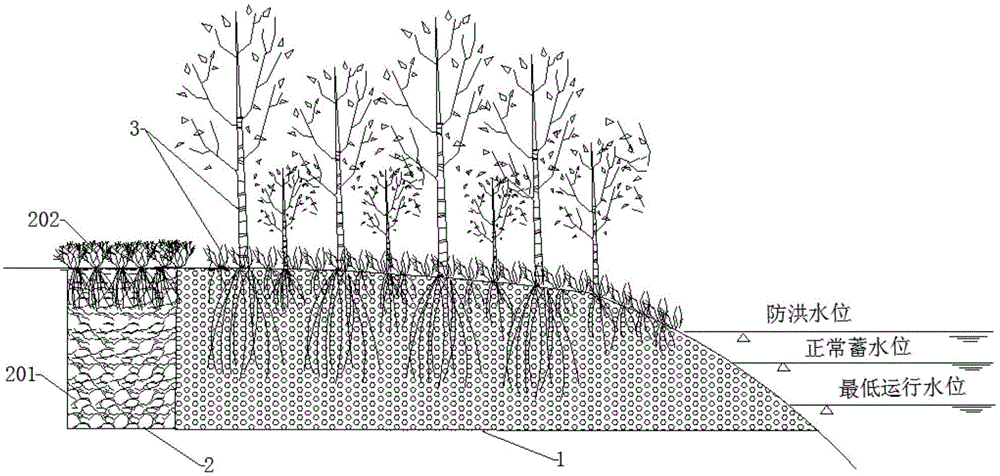Lake buffer zone building method for non-point source pollution control
A non-point source pollution and buffer zone technology, applied in chemical instruments and methods, construction, biological water/sewage treatment, etc., to achieve the effect of reducing non-point source pollution load, simple operation, and realizing resource utilization
- Summary
- Abstract
- Description
- Claims
- Application Information
AI Technical Summary
Problems solved by technology
Method used
Image
Examples
Embodiment 1
[0025] Such as figure 1 As shown, the lake buffer zone construction method for non-point source pollution control of the present invention comprises the following steps: select the area between farmland, villages and lakes (the range between the flood control level and the minimum operating water level is 1.7m) as the basis to establish the buffer zone , the buffer zone includes a vegetation zone 1 planted with native plants 3, the end away from the lake is the front end, and a reinforced matrix zone 2 is constructed at the front end of the vegetation zone 1, which is composed of an adsorption matrix 201 and herbs planted thereon Plant 202 constitutes. The adsorption matrix is a mixture of red soil and waste sludge from water supply plants, in which Fe in red soil 2 o 3 The mass ratio accounts for 16.2%; the waste sludge of the water supply plant is the sludge produced by the water supply plant with aluminum salt as the flocculant, Al 2 o 3 The mass ratio accounts for 8....
Embodiment 2
[0030] The difference from Example 1 is that the adsorption matrix 201 is a mixture of red soil and waste sludge from a water supply plant, and the mixing ratio of the two is 2:1.
Embodiment 3
[0032] Such as figure 2 As shown, the difference from Embodiment 1 is that a reinforced matrix belt 2 is constructed in the middle of the vegetation belt 1 . The reinforced matrix belt 2 is composed of an adsorption matrix 201 and herbaceous plants 202 planted on it. The adsorption matrix 201 is a mixture of red soil and waste sludge from a water supply plant. Fe in the red soil 2 o 3 The mass percentage is 20.7%; the waste sludge of water supply plant is the sludge produced by water supply plant with aluminum salt as flocculant, Al 2 o 3 The mass ratio of the two is 6.3%, and the mixing ratio of the two is 3:1.
[0033] The base of the vegetation zone 1 is the original silty soil in the area between farmland, villages and lakes (the difference between the flood control level and the lowest water level is 1.7m), and the native plants are mainly trees such as red willow and metasequoia and herbaceous plants such as Bermuda. Vegetation zone 1 has a width of 100m, its end st...
PUM
| Property | Measurement | Unit |
|---|---|---|
| width | aaaaa | aaaaa |
| width | aaaaa | aaaaa |
| depth | aaaaa | aaaaa |
Abstract
Description
Claims
Application Information
 Login to View More
Login to View More - R&D
- Intellectual Property
- Life Sciences
- Materials
- Tech Scout
- Unparalleled Data Quality
- Higher Quality Content
- 60% Fewer Hallucinations
Browse by: Latest US Patents, China's latest patents, Technical Efficacy Thesaurus, Application Domain, Technology Topic, Popular Technical Reports.
© 2025 PatSnap. All rights reserved.Legal|Privacy policy|Modern Slavery Act Transparency Statement|Sitemap|About US| Contact US: help@patsnap.com


